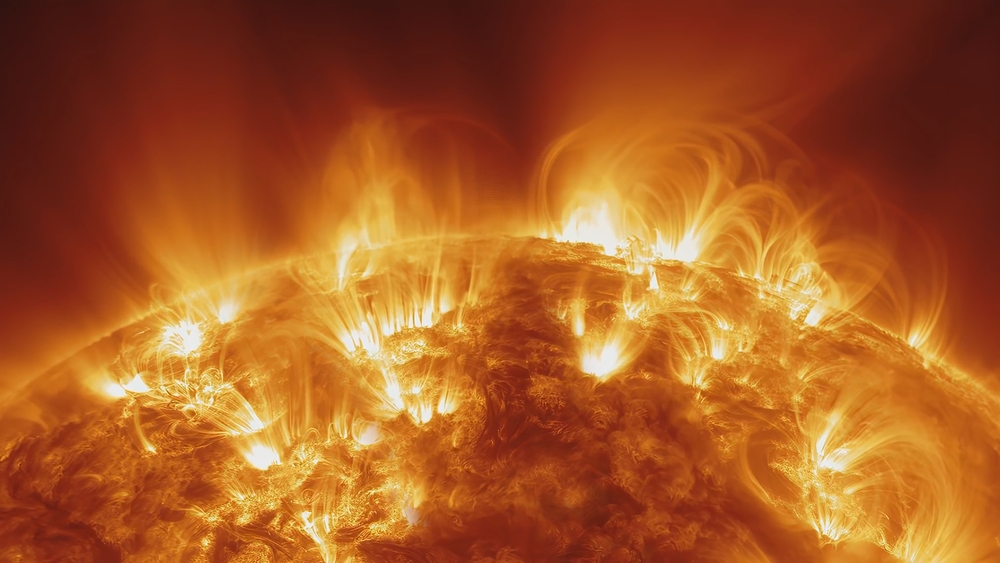Puzzle of the sun's mysterious 'heartbeat' signals finally solved
After studying an unusual solar eruption from 2017, researchers think they've pinpointed the likely origin of mysterious heartbeat-like signals emitted by the sun during solar flares.

Researchers have finally pinpointed the likely origin of mysterious heartbeat-like signals spat out by the sun during solar flares. The findings could help us learn more about how potentially damaging solar storms are unleashed, a new study shows.
Solar radio bursts are streams of electromagnetic radiation — made up mainly of radio waves, as well as microwaves, ultraviolet radiation and X-rays — that get launched into space along with jets of superhot plasma, known as coronal mass ejections (CMEs), during solar flares.
Solar radio bursts, as well as some stellar radio bursts from distant stars, occasionally contain regularly repeating patterns known as quasi-periodic pulsations (QPPs). These patterns involve brief breaks in the radiation stream, which create troughs and peaks when viewed on a graph, similar to an electrocardiogram (ECG or EKG), a recording of the electrical signals from the heart.
"These beating patterns are important for understanding how energy is released and is dissipated in the Sun's atmosphere during these incredibly powerful explosions," Sijie Yu, a solar radio astronomer at the New Jersey Institute of Technology (NJIT) and co-author of the study, said in a statement. "However, the origin of these repetitive patterns has long been a mystery and a source of debate among solar physicists."
Related: Strange 'heartbeat' signal spotted coming from deep space
In the study published Dec. 12, 2022, in the journal Nature Communications, Yu and colleagues analyzed a heartbeat signal contained within a medium C-class flare that harmlessly erupted from the sun on July 13, 2017. (Solar flare classes include A, B, C, M and X, with each class being at least 10 times more powerful than the previous one.)
After analyzing data collected by NJIT's Expanded Owens Valley Solar Array (EOVSA) in California and NASA's Solar Dynamics Observatory, the team discovered a secondary heartbeat signal. The "unexpected" second signal, which seemed to be linked to the original signal, allowed the researchers to pinpoint what was happening during solar flares to trigger the pair of signals, Yu said.
Sign up for the Live Science daily newsletter now
Get the world’s most fascinating discoveries delivered straight to your inbox.
Tracing back the signals
Solar flares happen when the sun's magnetic field lines get tangled up and then snap back into place like a rubber band. This process unleashes an enormous amount of energy and forces superheated loops of ionized gas, or plasma, and radiation into space.
The fast-moving plasma creates a current, or stream of charged particles, that runs vertically down the center of the plasma loop in a thin sheet. Disruptions to these "current sheets" are believed to be the source of the "beats" in QPP signals. But, until now, nobody knew what caused the disruptions.
The main heartbeat signal detected during the 2017 solar flare, which beat every 10 to 20 seconds, was traced back to the base of the current sheet, like most other QPP signals detected in other solar flares. But the secondary signal, which was weaker than the main signal and beat every 30 to 60 seconds, came from across the entire current sheet, which has not been observed before.
Using the data collected by EOVSA, the team found that, despite their different periodicities, the two heartbeats likely had the same trigger: bubble-like structures known as "magnetic islands," which form in the current sheet.
Now, the researchers want to reanalyze data from other QPP signals to see if they likely formed from magnetic islands too.

Harry is a U.K.-based senior staff writer at Live Science. He studied marine biology at the University of Exeter before training to become a journalist. He covers a wide range of topics including space exploration, planetary science, space weather, climate change, animal behavior and paleontology. His recent work on the solar maximum won "best space submission" at the 2024 Aerospace Media Awards and was shortlisted in the "top scoop" category at the NCTJ Awards for Excellence in 2023. He also writes Live Science's weekly Earth from space series.










